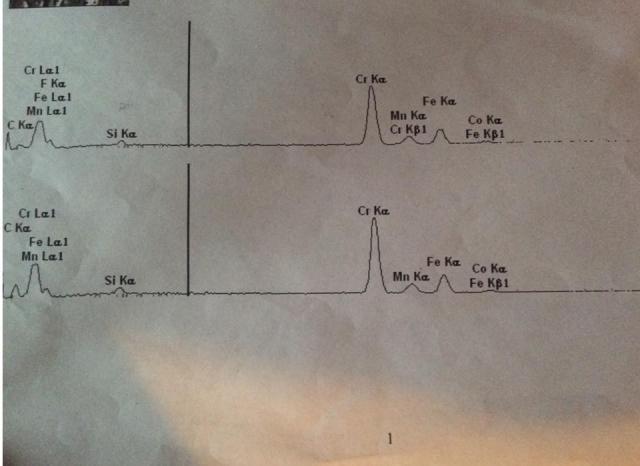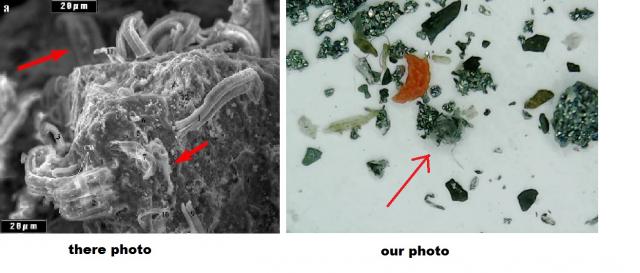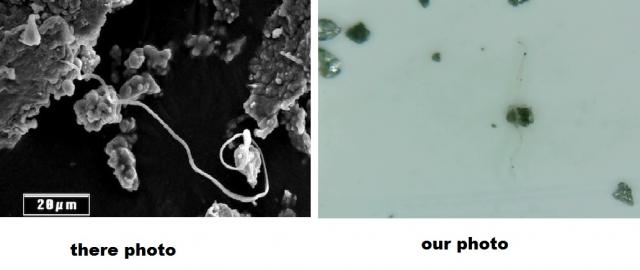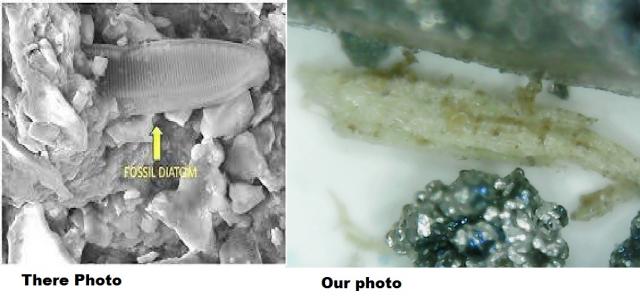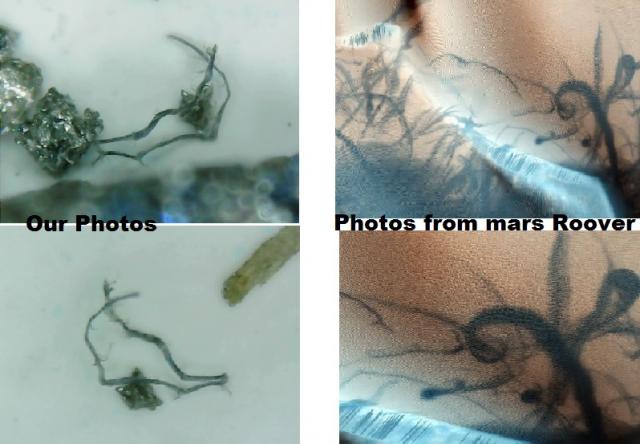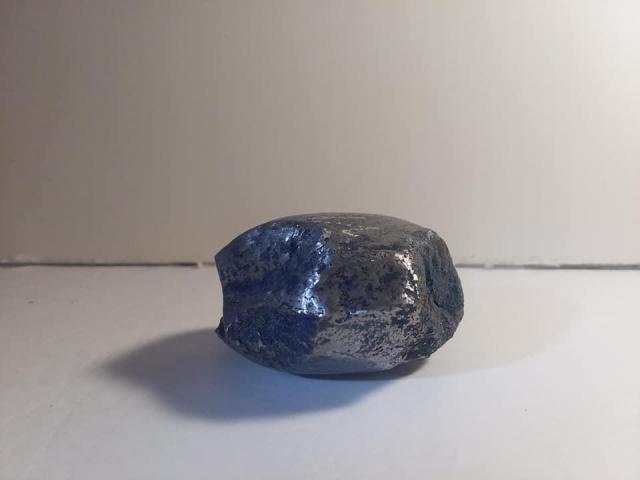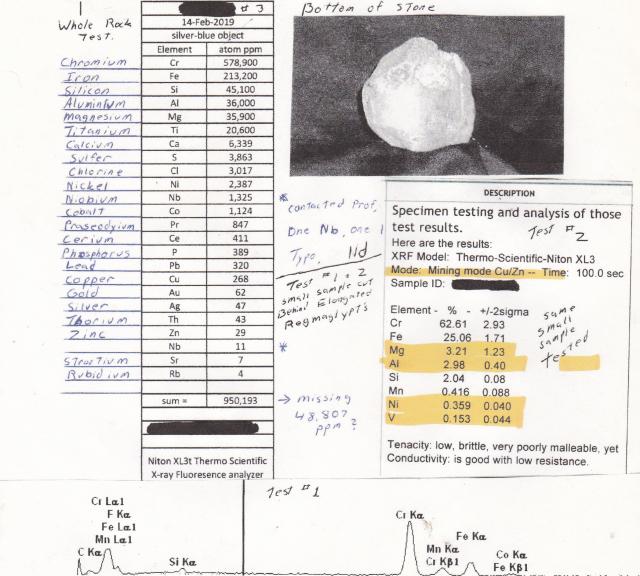Printable Version of Topic
Click here to view this topic in its original format
Colorado Prospector - Gem and mineral prospecting and mining forums _ Space and Astronomy _ Please Help Identify (updated information)
Posted by: CoolGems312 Oct 9 2016, 06:53 PM
In one’s opinion, it is a meteorite, but not an ordinary specimen. Extensive researches online and under a microscope show the possibility of extremely unique and rare meteorite. Why? It has NM size blue bubbles impacted on its surface, kind of like the ones found on NASA’s equipment from the Mars landing. It has the cone shape, along with the thumb prints on the front edge, a rounded underbelly, and a large roll over lip on the trailing edge (not seen in photo). The object has a weak magnetic attraction and leaves a light grey steak. It’s heavy for its size and the interior is a metallic luster. When using a hammer, the object will chip and crush like stone, and viewing under a microscope, it reviles other materials inside the stone. An inclusion in the saw marks reviles other properties such as white globules, yellow, light and dark green, as well as particles that sparkle like diamonds. The amazing part is that also when crushed; it shows the possibility of fossilized micro bacteria organisms. They are NM size fibers that are hair like with other hairs coming out of them and were 1/100th size of human hair or smaller. The possibility of fossilized life inside a meteorite was discussed by Dr. R. Hoover and suggests that hairs inside of the stone indicated that the organisms were present at the time the stone formed. Note: More than one hair like fiber was found in the rock was not contaminated after its fall to Earth. Under a microscope, the object shows the same characteristics- almost exact, as mars meteorite rare online photos. One is Hopeful to get photos of magnified images of possibly fossilized organisms.
Being of unknown origin, it could be a suspected lunar, mars, or comet specimen as it has still yet to be identified. The most online research was done on various NASA websites and other institutes that focus in meteorite studies. One conflicting bit of information on rare meteorites is that there are only a handful of people who are skilled in testing or have ever seen such an object. NASA has meteorites that the public does not get to see. One is Unable to match photo with online photos of ordinary meteorites, and without positive analysis and extensive testing by a handful of professors, it may be difficult to identify.
One also noted when he photographed it and printed pictures of the rock in black and white that he noticed a silhouette of a man and 13 other faces and figures in the pictures. He called it a ‘galactic jail’ and said it could be a very valuable unique collectable unidentified object of art.
So that’s ones opinion. Any ideas?
For the former post information, which was about 2 years ago, please view here:
http://www.coloradoprospector.com/forums/index.php?showtopic=4675&hl=CoolGems312
Posted by: Bryan K Oct 9 2016, 07:02 PM
Very interesting specimen. I can see from the picture of your previous post the degree of Iron in the specimen. Normally the bluish green is an indicator of oxidized copper. I have found meteorites in the past out metal detecting, though they were pure iron. Who knows....We still don't know our own planet let alone what the cosmos can provide. For your sake I hope that it is a meteorite. That would without a doubt be rare and highly collectible specimen.
Posted by: EMac Oct 10 2016, 12:58 PM
Actual data on an unknown sample? Cool!! Looks like a XRF spectrum to me. Can you indicate where on the sample these spectra were taken from? I'm curious if it was the "silvery area", the blue area or if they're confounded.
From what I understand, the vast majority of meteorites have nickel present in significant quantities, but I don't see it in the spectra. I'm not saying that's conclusive, but it's not encouraging with respect to it being a meteorite. See http://geology.com/meteorites/meteorite-identification.shtml or http://meteorites.wustl.edu/id/metal.htm
I'm no materials expert, so I searched for chromium alloys with iron, manganese, and a little carbon, silicon and cobalt to boot. Cobalt chromite blue has a similar XRF spectrum shape (http://chsopensource.org/cerulean-blue-z-c0040/), but it's hard to compare without the excitation voltages listed on your plots, and lack of element callouts on the CHS-posted spectrum. Looking at relative ratios of chromium to iron, manganese, silicon and carbon, your sample appears to be an alloy of http://www.chemistrylearner.com/ferrochrome.html to me.
I wouldn't bet any money on my guess though.
Posted by: CoolGems312 Oct 15 2016, 01:45 PM
Thanks again for your responses- They really help us in ideas of where to search.
The tests were done on the bare silver part of the stone, off of the back side with no blue.
The ferrochrome sounds interesting, we may do more research on that..
We just placed an order for a usb microscope, so hopefully more zoomed in photos
will be available soon.
Posted by: CoolGems312 Nov 19 2016, 05:43 PM
Here are the photos we were hoping to get that are microscopic views of the unknown specimen.
They are compared to photos that haven been proven to be from that of mars meteorites.
What are your thoughts?
Posted by: EMac Dec 1 2016, 09:21 AM
Seeing a fossil diatom in your picture of a meteorite piqued my curiosity, and now I'm reading about http://www.npr.org/sections/thetwo-way/2013/03/11/174041948/claims-of-a-meteorites-ancient-aquatic-fossils-spark-debate.
What's the scale on your pictures? I see 20 microns on the SEM pics, so ~120 microns side to side, but your scale appears to be much larger (millimeters vs microns).
Posted by: CoolGems312 Dec 3 2016, 04:43 PM
I'm actually not entirely sure on what the exact scale is,
how ever I do know that our microscope goes up to 200 times
zoom. I suppose that doesn't really help much..
The fossilized looking objects are not visible to the naked eye..
You can only imagine our shock at seeing them in what we consider
to be an unknown specimen.
Posted by: CoolGems312 Dec 3 2016, 05:54 PM
Also we have a couple of new photos.
The photos on the left are of dust particles, and of more possible fossilized objects that were found with in our
specimen. Where as the photos on the right are of dust particles found from the lens of the mars rover equipment
from dust devils that happened on mars.
Powered by Invision Power Board (http://www.invisionboard.com)
© Invision Power Services (http://www.invisionpower.com)
